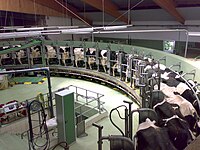
Photo from wikipedia
Introduction of microbial contaminations in the dairy value chain starts at the farm level and the initial microbial composition may severely affect the production of high-quality dairy products. Therefore, understanding… Click to show full abstract
Introduction of microbial contaminations in the dairy value chain starts at the farm level and the initial microbial composition may severely affect the production of high-quality dairy products. Therefore, understanding the farm-to-farm variation and longitudinal shifts in the composition of the bulk tank milk microbiota is fundamental to increase the quality and reduce the spoilage and waste of milk and dairy products. In this study, we performed a double experiment to study long- and short-term longitudinal shifts in microbial composition using 16S rRNA gene amplicon sequencing. We analyzed milk from 37 farms, that had also been investigated two years earlier, to understand the stability and overall microbial changes over a longer time span. In addition, we sampled bulk tank milk from five farms every 1–2 weeks for up to 7 months to observe short-term changes in microbial composition. We demonstrated that a persistent and farm-specific microbiota is found in bulk tank milk and that changes in composition within the same farm are mostly driven by bacterial genera associated with mastitis (e.g., Staphylococcus and Streptococcus). On a long-term, we detected that major shift in milk microbiota were not correlated with farm settings, such as milking system, number of cows and quality of the milk but other factors, such as weather and feeding, may have had a greater impact on the main shifts in composition of the bulk tank milk microbiota. Our results provide new information regarding the ecology of raw milk microbiota at the farm level.
Journal Title: Frontiers in Microbiology
Year Published: 2021
Link to full text (if available)
Share on Social Media: Sign Up to like & get
recommendations!